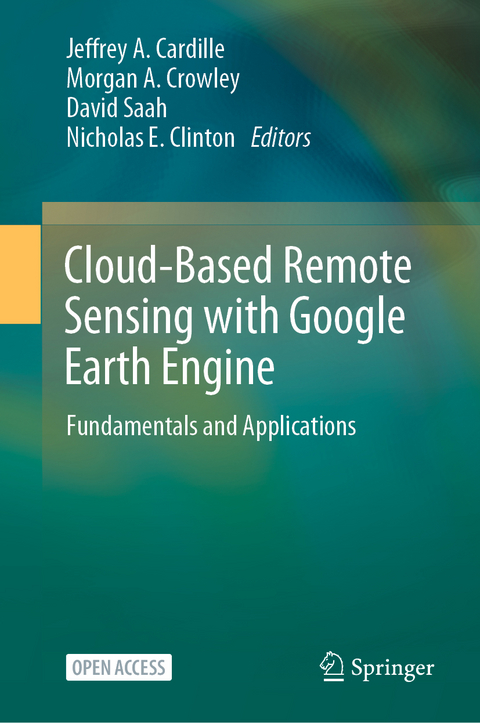
Cloud-Based Remote Sensing with Google Earth Engine
Springer International Publishing
978-3-031-26587-7 (ISBN)
Cloud Based Remote Sensing with Google Earth Engine is broadly organized into two halves. The first half, Fundamentals, is a set of 31 labs designed to take the reader from being a complete Earth Engine novice to being a quite advanced user. The second half, Applications, presents a tour of the world of Earth Engine across 24 chapters, showing how it is used in a very wide variety of settings that rely on remote-sensing data
This is an open access book.
Jeffrey Cardille
An Associate Professor at McGill University, Jeff is trained in landscape ecology, computer science, and remote sensing / GIS. A very early adopter of Earth Engine, his research focuses on ingesting multiple data sources to improve land-cover classifications, by smoothing inconsistencies through time and accumulating evidence of land cover change and stability. Through the years, one of the challenges in training new graduates and undergraduates has been finding training materials that both teach fundamentals and present interesting applications of using satellites for cutting-edge environmental science. Jeff hopes that this effort will appeal to individuals working on their own to understand this powerful technology. He has a Bachelor's Degree in Applied Mathematics and Computer Science from Carnegie-Mellon University, a Master of Science in Operations Research from the Georgia Institute of Technology, and a PhD in Environmental Monitoring from the University of Wisconsin-Madison.
Nick Clinton
Nick is on the Earth Engine developer relations team. He received a bachelors, masters and PhD from the Department of Environmental Science, Policy and Management at UC Berkeley. From 2008-2011, Nick worked in the Airborne Sensor Facility of NASA Ames Research Center, producing science quality calibrated imagery and supporting sensor maintenance for thermal, multispectral and hyperspectral imagers. From 2012-2015, he was on the faculty of the Center for Earth System Science at Tsinghua University, in Beijing, China. He joined Google in 2015.
Morgan A. Crowley
Morgan is a Forest Fire Research Scientist with NRCan at the Great Lakes Forestry Centre - Canadian Forest Service and the Tier 2 scientific lead of the WildFireSat mission that will be launched in 2028. She recently completed her Ph.D. at McGill University, where her research explored novel applications of fire monitoring using Google Earth Engine and multi-sensor satellite data fusion. Morgan has been recognized for her research and outreach using Google Earth Engine, including as a 2022-2023 Google Developer Expert, a Geospatial Rising Star by Geospatial World Media, and a leader in ML4EO by Radiant Earth Foundation. She is also the co-director of the Ladies of Landsat organization, which works to increase support for underrepresented scientists in the field of remote sensing.
David Saah
A Professor at the University of San Francisco, David is an environmental scientist with expertise in a number of areas including: landscape ecology, ecosystem ecology, hydrology, geomorphology, ecosystem modeling, natural hazard modeling, remote sensing, geographic information systems (GIS) and geospatial analysis. His academic research uses integrated geospatial science for multi-scale mapping, monitoring and modeling of environmental spatial heterogeneity, particularly in riparian, savanna, and forest ecosystems. Dr. Saah's long-running work with the NASA SERVIR project has focused on outreach to developing nations, working to build knowledge infrastructure to solve pressing environmental problems.
Part 1: Programming and Remote Sensing Basics.- 1. JavaScript and the Earth Engine API.- 2. Exploring Images.- 3. Survey of Raster Datasets.- 4. The Remote Sensing Vocabulary.-Part 2: Interpreting Images.- 5. Image Manipulation: Bands, Arithmetic, Thresholds, and Masks.- 6. Interpreting an Image: Classification.- 7. Accuracy Assessment: Quantifying Classification Quality.- Part 3: Advanced Image Processing.- 8. Interpreting an Image: Regression.- 9. Advanced Pixel-based Image Transformation.- 10. Neighborhood-based Image Transformation.- 11. Object-based Image Analysis.- Part 4: Interpreting Image Series.- 12. Filter, Map, Reduce.- 13. Exploring Image Collections.- 14. Aggregating Images for Time Series.- 15. Clouds and Image Compositing.- 16. Change Detection.- 17. Interpreting Annual Time Series with LandTrendr.- 18. Fitting Functions to Time Series.-19. Interpreting Time Series with CCDC.- 20. Data Fusion: Merging Classification Streams.- 21. Exploring Lagged Effects in Time Series.- Part 5: Vectors and Tables.- 22. Exploring Vectors.- 23. Raster/Vector Conversions.- 24. Zonal Statistics.- 25. Advanced Vector Operations.- 26. GEEDiT - Digitizing From Satellite Imagery.- Part 6: Advanced Topics.- 27. Advanced Raster Visualization.- 28. Collaborating in Earth Engine with Scripts and Assets.- 29. Scaling up in Earth Engine.- 30. Sharing Work in Earth Engine: Basic UI and Apps.- 31. Combining R and Earth Engine.- Part 7: Human Applications.- 32. Agricultural Environments.- 33. Urban Environments.- 34. Built Environments.- 35. Air pollution and population exposure.- 36. Heat Islands.- 37. Health Applications.- 38. Humanitarian Applications.- 39. Monitoring Gold Mining Activity using SAR.- Part 8: Aquatic and Hydrological Applications.- 40. Groundwater monitoring with GRACE.- 41. Benthic Habitats.- 42. Surface Water Mapping.- 43. River morphology.- 44. Water Balance and Drought.- 45. Defining Seasonality: First Date of No Snow.-Part 9: Terrestrial Applications.- 46. Active fire monitoring.- 47. Mangroves.- 48. Mangroves II - Change Mapping.- 49. Forest Degradation and Deforestation.- 50. Deforestation Viewed from Multiple Sensors.- 51. Working With GPS & Weather Data.- 52. Creating Presence and Absence Points.- 53. Detecting Land Cover Change in Rangelands.- 54. Conservation I - Assessing the spatial relationship between burned area and precipitation.- 55. Conservation II - Assessing Agricultural Intensification Near Protected Areas.
| Erscheint lt. Verlag | 5.10.2023 |
|---|---|
| Zusatzinfo | XXI, 1226 p. 1493 illus., 1464 illus. in color. In 2 volumes, not available separately. |
| Verlagsort | Cham |
| Sprache | englisch |
| Maße | 155 x 235 mm |
| Gewicht | 2358 g |
| Themenwelt | Sachbuch/Ratgeber ► Natur / Technik ► Natur / Ökologie |
| Technik ► Umwelttechnik / Biotechnologie | |
| Schlagworte | Big Data • Cloud Computing • Historical change • Image Processing • open access • Remote Sensing • Satellite Imagery |
| ISBN-10 | 3-031-26587-4 / 3031265874 |
| ISBN-13 | 978-3-031-26587-7 / 9783031265877 |
| Zustand | Neuware |
| Haben Sie eine Frage zum Produkt? |
aus dem Bereich


